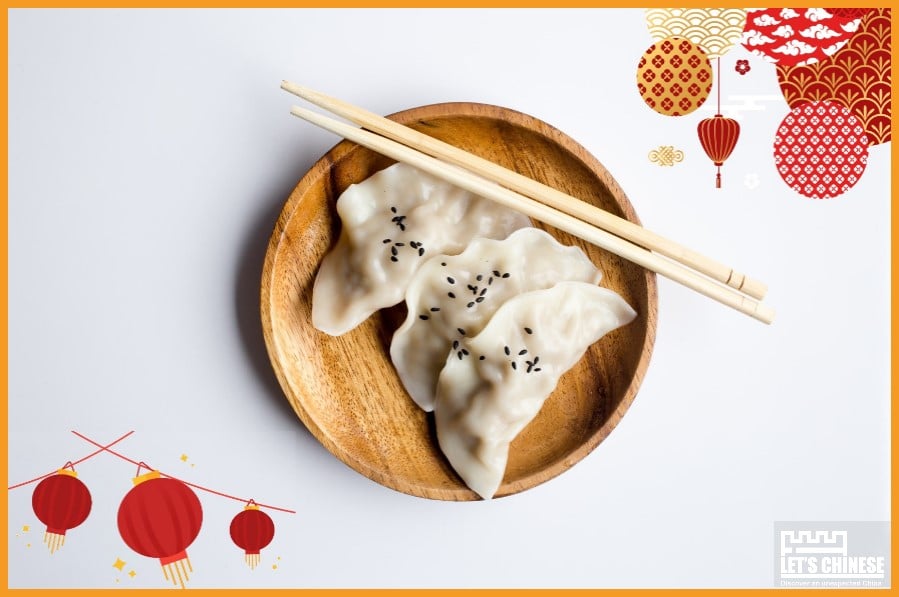I have to say, being Chinese, the Chinese New Year, or Lunar New Year, is my favorite and most expected day of the whole year. It’s actually celebrated in several Asian countries, sometimes we also call it Spring Festival.
It is a time to bring families together. I can meet my Mon and Dad, sometimes my relatives, and have the “reunion dinner” together which is such an important New Year’s tradition. You can see an ample variety of food on the table!
Normally, an elaborate reunion dinner is going to include all sorts of stuff, to indicate that you’re so successful during the year that you can afford all of this.
Eating during Chinese New Year holds a symbolic place within the festivities. Some of them are symbols of luck and prosperity, and some of them are just because of the traditional routine.
Just FYI, if you're looking for a way to buy things from China, you can sign up for Superbuy, which is one of the most reliable Taobao agents in China, and then, you can buy whatever you want from Taobao with a nice bargain. Here's a beginner guide for using Superbuy.
So what traditional food to eat during the Chinese New Year? Here are 22 Chinese New Year traditional foods for you to celebrate the upcoming Chinese New Year in 2024.
- Dumplings (饺子 / 餃子)
- Tangyuan / Yuanxiao (汤圆 / 元宵 / 湯圓)
- Fish (鱼 / 魚)
- Wonton (馄饨 / 餛飩)
- Sticky rice cake / Nian gao (年糕)
- Babao rice (八宝饭 / 八寶飯)
- Chicken (鸡 / 雞)
- Glutinous rice cake (糍粑)
- Spring Rolls (春卷)
- Noodle (面 / 麵)
- Soybean sprout (黄豆芽 / 黃豆芽)
- Spring pancake (春饼 / 春餅)
- Yuanbao Soup (元宝汤 / 元寶湯)
- Sugar melon (糖瓜)
- Tu Su wine (屠苏酒 / 屠蘇酒)
- Rice with rice (二米子饭 / 二米子飯)
- Crisp sugar (酥糖)
- Red melon seeds (红瓜子 / 紅瓜子)
- Sesame crisp, peanut crisp (芝麻酥,花生酥)
- Oil fruit / You Guo (油果)
- Sticky Bean Bun (粘豆包 )
- Cured meat (腊味 / 臘味 )
- People also ask about Chinese New Year traditional foods
Dumplings (饺子 / 餃子)

The custom of eating dumplings during the Spring Festival in China has a long history. Eating dumplings on the first day of the lunar new year is a custom that almost every family in northern China will follow.
This dumpling meal is different from other dumplings in the year. The dumplings are required to be wrapped on New Year’s Eve and eaten at midnight.
Some places will put coins, peanuts, and other things in the dumplings, and whoever eats them represents good luck in the new year, which is a good omen
At the big dinner table in the north, dumplings are a big feast food that can’t be replaced by any delicacies.
Tangyuan / Yuanxiao (汤圆 / 元宵 / 湯圓)

The southern Chinese normally call it “Tangyuan” while northern Chinese call it “Yuanxiao”. Since I’m from the south of China, I’ll call it Tangyuan in this post.
In Jiangsu, Shanghai, and other places, it is customary to eat Tangyuan on the morning of the Chinese New Year. Eating Tangyuan has a very long history in China. In the Ming Dynasty, Tangyuan has become a very common food, and it is basically no different from today’s Tangyuan.
Because Tangyuan is in the shape of a sphere and is “floating” in a bowl of boiled water, which looks a lot like a bright moon hanging in the sky, symbolizing the auspicious meaning of reunion.
In the old days, it was still popular in Jiangsu and Zhejiang to wrap small money in Tangyuan. Whoever ate it had “good luck”. Tangyuan is popular in many areas, but Ningbo Tangyuan and Chengdu Tangyuan are the most famous.
Fish (鱼 / 魚)
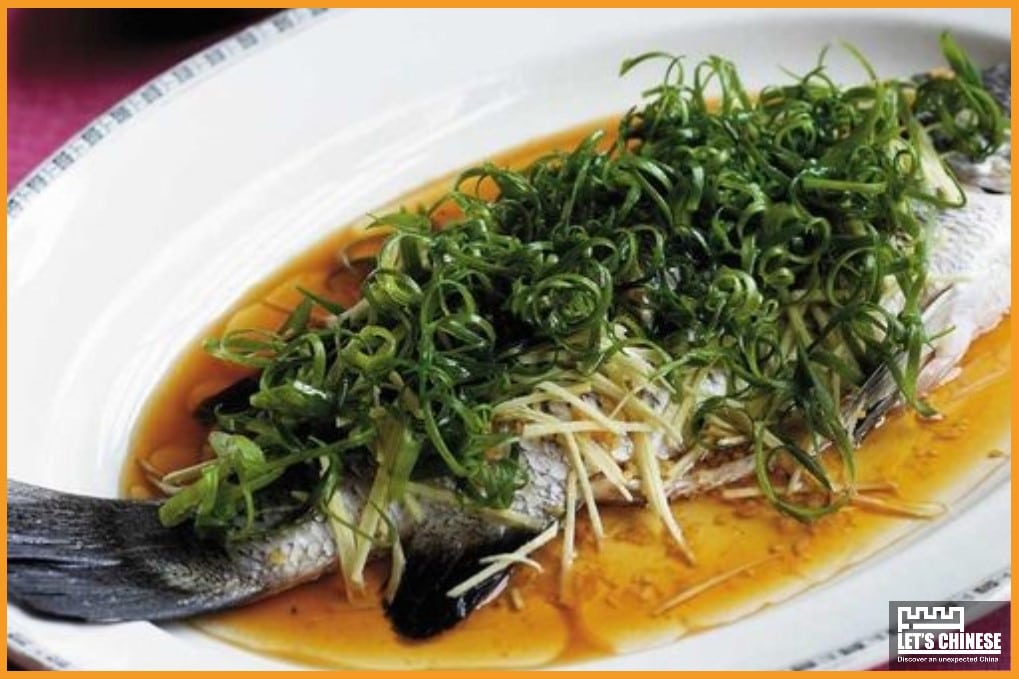
Fish is usually the last dish on the table. Fish should be the last dish on the new year’s Eve dinner, and it can’t be eaten, which symbolizes “surplus” every year.
In other places, fish heads and tails should be reserved for the first day of the lunar new year, which means that there is a “surplus” from beginning to end of the year.
Even though fish is quite a regular food in our daily life, during the Spring Festival, we’ll pay extra attention to the selection of fish types. Different kinds of fish represent different meanings.
Wonton (馄饨 / 餛飩)

In Jingjiang city of Jiangsu Province, we must eat wontons to celebrate New Year’s festivals. On the morning of the day before the lunar new year, my family will begin to pack wonton.
Then the wrapped wonton will be put in the refrigerator and kept for the evening to eat. During the Spring Festival, people will eat wontons for days, from the 31st of the year to the 15th of the first month
Wonton, homonymous with “chaos”, meaning the chaos before the new beginning, and eating wonton symbolizes the new beginning. Another reason is that the shape of wonton is like a Yuanbao (a kind of ancient currency made of gold).
There’s also something special about the way we wrap wonton. You must pinch the two corners of wonton skin and wrap it inside, which means “collecting money”.
Sticky rice cake / Nian gao (年糕)

Sticky rice cakes have the meaning of getting higher every year. There are many ways to make Sticky rice cakes. Each place’s Sticky rice cakes have their own unique ways.
Eating Sticky rice cakes during the Spring Festival is a custom in many places, such as red / White Sticky rice cakes in Fujian, Shuimo Sticky rice cakes in Ningbo, osmanthus sugar Sticky rice cakes in Suzhou, Baiguo Sticky rice cakes in Beijing, northern style sticky cakes, etc.
Because the Sticky rice cake is also called “New Year cake” in Chinese, which is homonymous with “getting higher every year”, eating “New Year cake” means that people’s work and life are getting better and better year by year.
Babao rice (八宝饭 / 八寶飯)

The Babao in Chinese means eight treasures and Babao rice is exquisite in cook. The process is quite complicated. Its quantity is enough for the whole family to share and enjoy, symbolizing reunion.
According to folklore experts, lotus seeds in Babao rice symbolize marriage harmony, longan symbolizes reunion, kumquat symbolizes auspiciousness, red jujube symbolizes wishing you have a great baby, honey wax gourd and honey cherry symbolize sweet life, job’s tears symbolize longevity, and melon seed kernel implies peace and no disaster.
From this point of view, the Babao rice is like a cornucopia, implying that money can roll in the new year.
Chicken (鸡 / 雞)
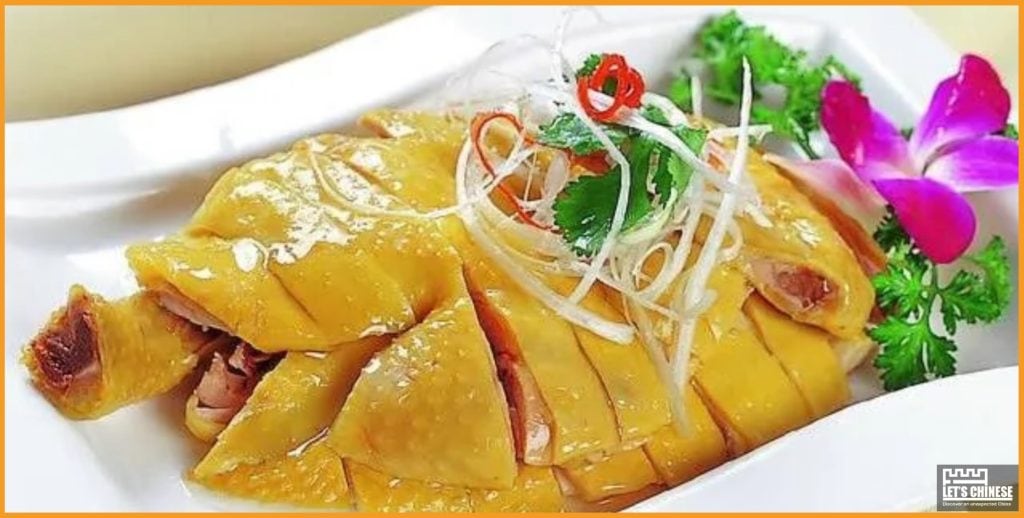
The Chinese word “吉 (ji)” means lucky and chicken is homonymous with “Ji”, In Guangdong, there is a saying that “there is no feast without chicken”.
Chicken is an indispensable food for the Cantonese new year. People eat chicken to pray for good luck and hope to prosper in the coming year.
Glutinous rice cake (糍粑)
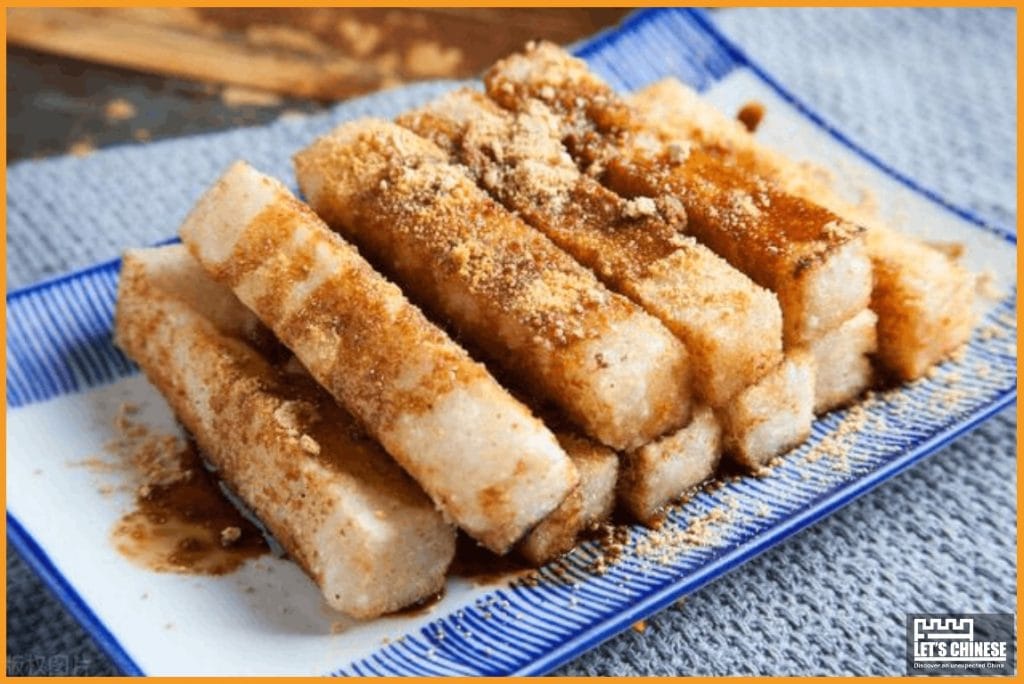
“Playing glutinous rice cake for the new year” is particularly popular in the western area of Hunan. Glutinous rice cake is made of glutinous rice and is very sticky. Eating glutinous rice cake during the new year symbolizes “sticking” families together, implying people’s reunion in the new year.
Glutinous rice cake is also a delicious snack in the Spring Festival, especially in the Wuyishan area of southern China. The whole family happily make glutinous rice cake together to prepare for the Spring Festival.
Glutinous rice cake is made of glutinous rice. After soaking in clear water, it will be steamed in a steamer, and then quickly pounded in a stone ladle until it is soft and flexible.
Take advantage of the heat to make the rice mud into a large or small ball shape, put it in the plate of sesame fried fragrant grinding powder mixed with white granulated sugar (or soybean fried fragrant grinding powder mixed with white granulated sugar), and then eat it with the sugar.
Spring Rolls (春卷)
Spring rolls are popular all over the country, especially in the Jiangnan area. Spring rolls are fried with leeks, bean sprouts, shredded meat, celery, shredded tofu, shredded chicken, mushrooms, and other ingredients, and then wrapped with pancakes to eat from beginning to end, representing “good things can be lasting from the beginning to the end”. Some places eat fried spring rolls.
Because the fried spring rolls look like gold bars, people symbolize it as wealth.
Noodle (面 / 麵)
Some areas in Fujian have the custom of eating noodles for the Chinese New Year. Noodles, known as the meaning of longevity, eat it in the new year symbolize every good thing can be lasting as long as possible.
Soybean sprout (黄豆芽 / 黃豆芽)
The people of Suzhou gave it a good name, called “Ruyi dish”. “Ruyi” in Chinese means wishful. Chinese people from Shanghai and Suzhou must have “Ruyi food” at the dinner table, wishing them all the best in the new year. In addition, Soybean sprout is a kind of sprouted vegetable, symbolizing rise and growth, which is very auspicious.
Spring pancake (春饼 / 春餅)
Chinese people eat traditional food at the beginning of spring in both north and south, but the styles are different. I think spring pancakes in the northeast and Beijing have the most delicious taste.
During the Spring Festival, preparing several dishes and baking a stack of thin cakes, you do not only have delicious food but also contain the good wishes of the new year.
Yuanbao Soup (元宝汤 / 元寶湯)
Yuanbao soup actually is a kind of wonton. Because the wonton looks really like a yuanbao, people call it Yuanbao soup. It is usually stuffed with pork, spinach, and leek.
In the north, it is necessary to sacrifice the God of wealth on the second day of the lunar new year. On this day, people from the north of China want to have Yuanbao soup. They’ll pray that the new year’s wealth will roll like soup.
Sugar melon (糖瓜)
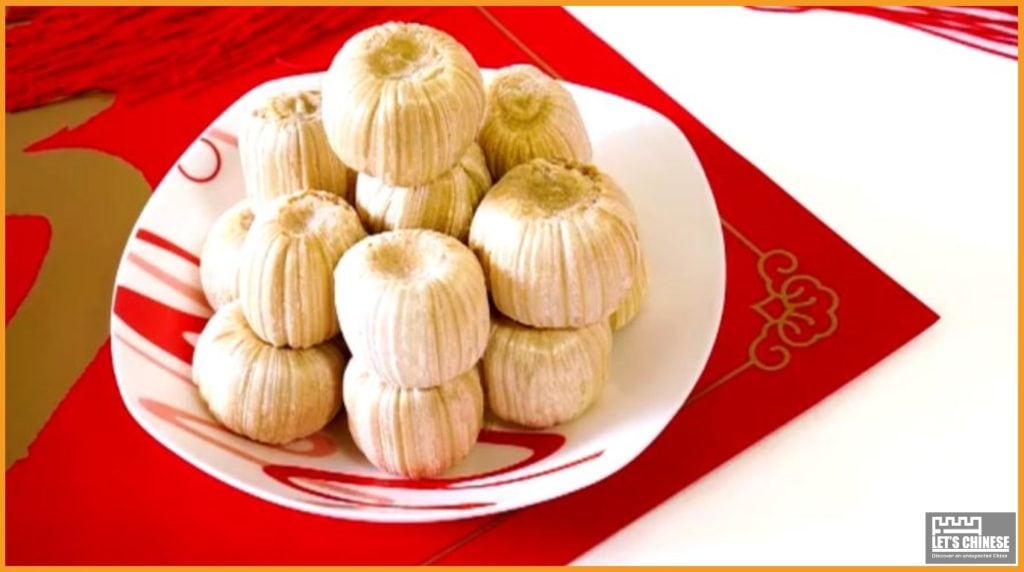
Sugar melon is actually boiled with millet and malt. It is quite common in rural areas and its viscosity is very large. In winter, people will put the sugar melon outside the house.
Because it is cold in winter, the sugar melon solidifies very strongly, and many bubbles are formed in the middle, which makes it very crisp. In rural areas, there is also the custom of eating sugar melon on the 23rd of the twelfth lunar month.
Sugar melon is round and fat. It is made of maltose, tasted sweet and slightly sour. It was a popular snack during the Chinese New Year but, unfortunately, it is quite rare now.
Tu Su wine (屠苏酒 / 屠蘇酒)
Tu Su is also known as “Tu Su”. Name of medicinal wine. Tusu is a grass name.
It is also said that Tusu is a kind of house in ancient China. Because the wine brewed in this house is called “Tusu wine”.
If you drink Tu Su wine on the first day of the lunar new year, all of your diseases will disappear in the new year, which has been a custom for thousands of years to drink Tusu wine in the new year.
It is said that it was created by Hua Tuo and later known by Sun Simiao of the Tang Dynasty. It has the effects of dispelling wind, dispersing cold, supplementing qi, and warming your body.
Rice with rice (二米子饭 / 二米子飯)
In the north, there is a folk custom of providing rice every other year, that is, rice made of millet and rice, prepared before the new year and provided for the new year, which means that there is surplus food every year and every family is well-off. The rice with rice is also called gold and silver rice because of its shape and color.
Crisp sugar (酥糖)
Crisp candy is a traditional pastry for the Spring Festival. It is in the shape of long strips, looks like mahjong. The blocks are neat and wrapped with wax paper. When eating, the crisp candy tastes soft, sweet, and greasy. I still remember the lingering fragrance.
Red melon seeds (红瓜子 / 紅瓜子)
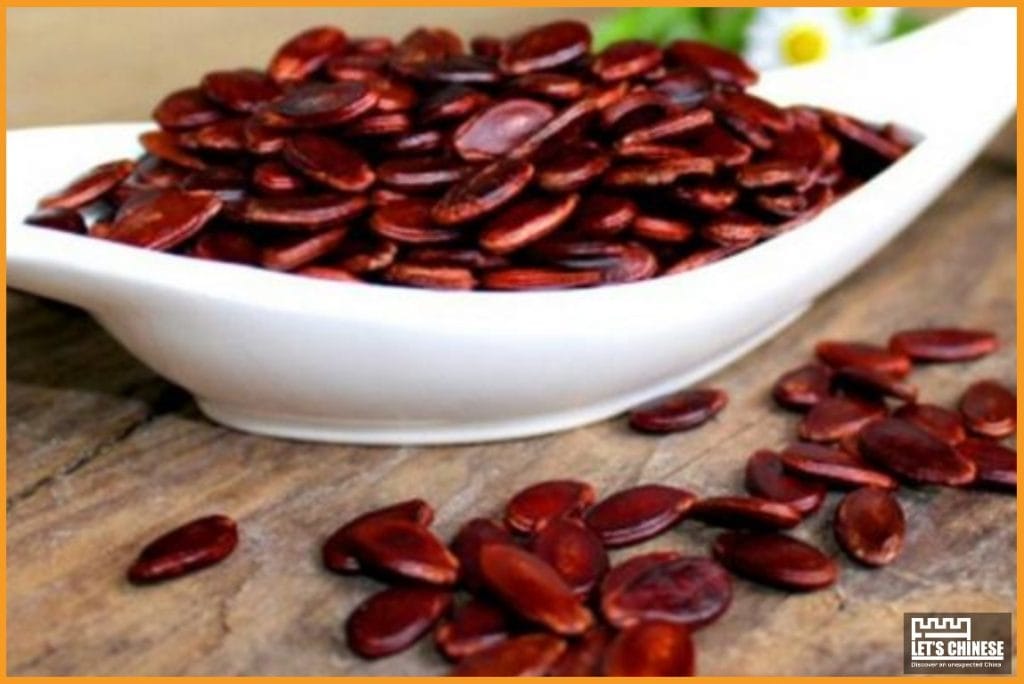
Melon seeds used to be a kind of food that only poor people will eat. In Chinese, we’re using the word “嗑(ke)” to refer to “eating” when we’re eating melon seeds and the word “嗑(ke)” in north China also means “drive away something”.
Therefore, eating melon seeds on New Year’s Eve was called driving away poor, which meant getting rid of poverty, the custom of eating melon seeds on New Year’s Eve becomes one of the routines.
Red melon seeds used to be an essential snack during the new year. The family gets together to chat, drink tea and knock a handful of red melon seeds. It’s essentially the taste of New Year!
But now, since there are so many other nuts and different types of melon seeds for people to choose from, the status of red melon seeds is far from what it used to be.
Sesame crisp, peanut crisp (芝麻酥,花生酥)
The production method is similar to beating fried rice. Take sesame and peanut kernel as raw materials, fry Sichuan sugar into a paste, stir with fried sesame and peanut kernel, pour it into a tin box, pave and compact it, and cut it into small squares with a knife.
Actually Sesame cake and peanut crisp symbolize nothing for Chinese New Year, but they are just appearing on my table every year. It is quite an indispensable food for the Chinese New Year.
Oil fruit / You Guo (油果)
In fact, oil fruit is not a fruit at all but a kind of fried snack. I think it’s because of its little sphere shape, which looks like those sphere fruit, people call it “fruit”.
To make oil fruit, first, grind the glutinous rice into powder, boil the sugar into sugar liquid and rub it evenly with the glutinous rice powder. The longer it is rubbed, the softer it becomes.
Knead the dough into balls the size of a table tennis ball, stick white sesame seeds on the surface, and then put it into an oil pan for frying. Fry the balls into crimson to start the pot.
During the Chinese new year, people consider oil fruit a great companion for drinking. Also, kids love this snack. I remember it’s an indispensable food for every meal during the new year when I was a child.
Sticky Bean Bun (粘豆包 )
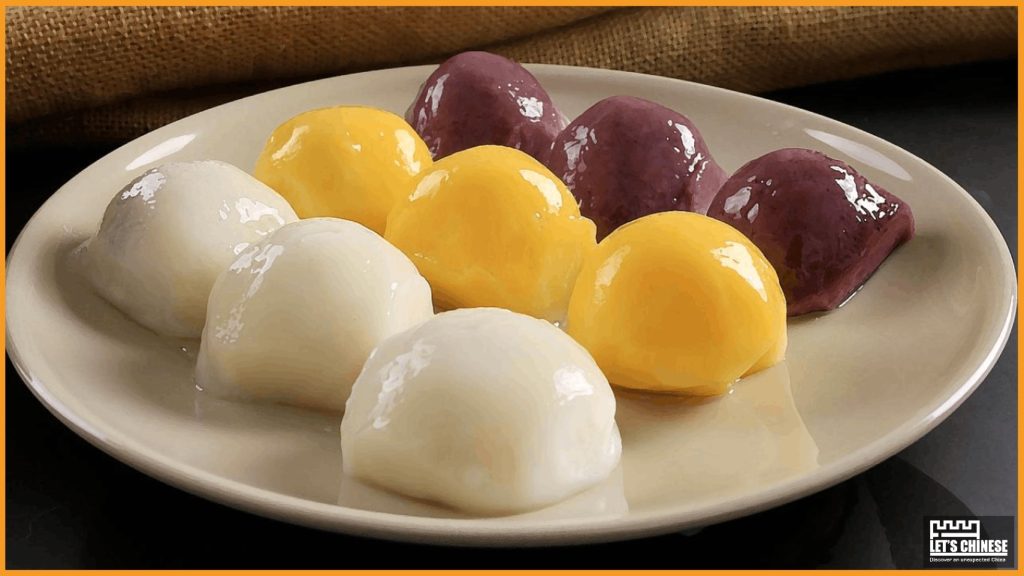
The word “sticky” in Chinese is pronounced “nian” which is the same way as the word “year” in Chinese, so “Sticky Bean Bun” is also considered relatively to symbolize Chinese New Year.
As the name suggests, it is the New Year cake wrapped during the new year. Sticky bean buns are mostly made of yellow rice flour, filled with cowpeas, red beans, or mung beans. Yellow rice flour is ground from millet, and there are different varieties of millet, including black millet and red millet.
Their viscosity and color are very different. The best shape is wide at the bottom and narrows at the top, smooth, round and small. It should be neatly placed on the cover curtain. It tastes sweet and soft.
Cured meat (腊味 / 臘味 )

In the past, cured meat was particularly popular in autumn and winter. Its unique flavor was formed through years of improvement and innovation. Chinese cured meat has bright colors, a fresh and sweet taste, and a unique flavor. It tastes crisp, tender, and delicious in the mouth.
One month before the Spring Festival, people began to prepare for the new year’s goods. They bought several Wuchang fish and ducks, washed them, cut them along the back of the fish, and evenly spread the fried pepper on the fish.
After such pickling, hang the fish up and air dry. When the new year comes, it will become a good dish.
People also ask about Chinese New Year traditional foods
In Guangdong, people normally won’t order squash because squash, or gwa, sounds similar to death in Cantonese.
In some places, porridge should not be eaten, because it is considered that only poor people have porridge for breakfast, and people don’t want to start the year “poor” as this is a bad omen.
When it comes to crab, the Cantonese pronunciation sounds too much like a depressing sigh of exasperation — hai.
It’s the year of the Tiger. The world will welcome the Year of the Rabbit on January 22., 2023.
2024 will be the year of the Dragon, which will be on Feb 10.

